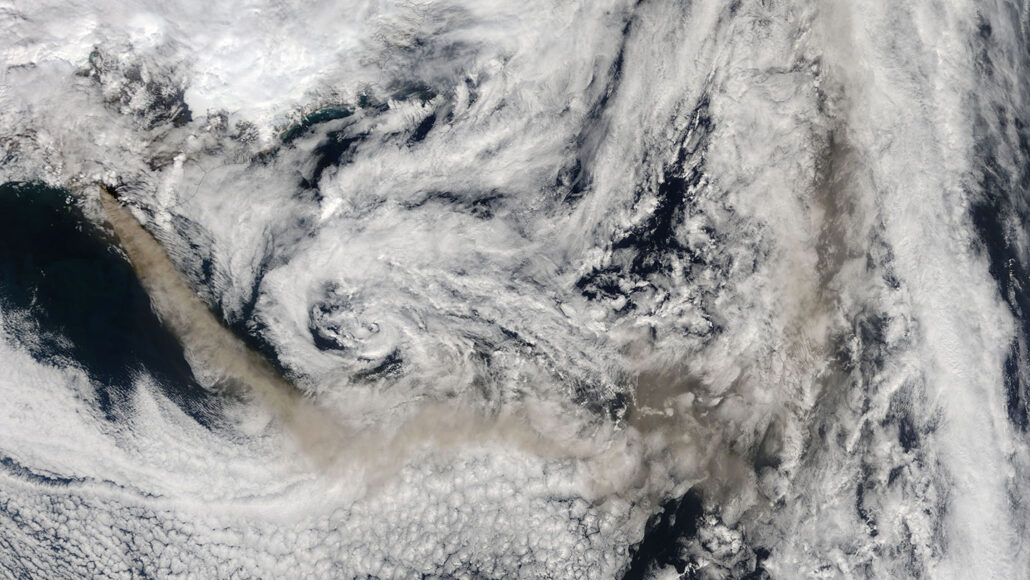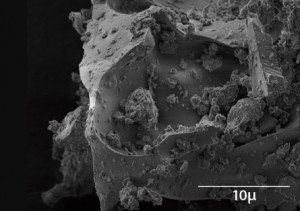Ash blast
Tiny particles ejected from a 2010 volcanic eruption pose big problems.

NASA’s Terra satellite captured this image of the brown, ashy volcanic plume mixing with weather clouds on May 13, 2010.
NASA/Goddard/MODIS Rapid Response Team
Share this:
- Share via email (Opens in new window) Email
- Click to share on Facebook (Opens in new window) Facebook
- Click to share on X (Opens in new window) X
- Click to share on Pinterest (Opens in new window) Pinterest
- Click to share on Reddit (Opens in new window) Reddit
- Share to Google Classroom (Opens in new window) Google Classroom
- Click to print (Opens in new window) Print
In April 2010, a volcano erupted in Iceland and blasted ash more than 6 miles into the air. The event didn’t impact only people in Iceland: A cloud of debris polluted skies all over Europe. Officials were worried that the ash would scratch airplane windows and clog jet engines. That’s why planes were grounded for seven days. It was to keep everyone as safe as possible. Newspapers reported that the delays cost billions of dollars and affected more than 10 million people.
“Aviation authorities made the right decision,” Susan Stipp told Science News. She should know: Stipp, a geoscientist at the University of Copenhagen in Denmark, recently led a study of the volcanic ash that ended up in the sky. Her team’s work shows that the ash was extremely dangerous. Its sharp and abrasive particles could have caused serious damage. Plus, small particles might have stuck to larger ones and later broken off. That suggests that the risk of breathing polluted air might have been higher than was previously thought.
Geoscientists investigate natural phenomena on Earth using a wide variety of scientific tools. Stipp and her colleagues conducted intensive physics and chemistry experiments on the debris from the volcano, called Eyjafjallajökull (for help with this tricky pronunciation, see the link under “Further Reading”). The team wanted to know the health and safety risks that ash posed to people — such as poisoned drinking water or polluted air.
Stipp received the ash samples from two volcanologists, Sigurdur Gíslason and Helgi Alfredsson. They work at the University of Iceland in Reykjavík. (Volcanologists, as you might expect, study volcanoes.) After the eruption, while most people were fleeing for safety, Alfredsson and Gíslason raced to the smoky scene to get fresh ash. Twelve days later, the researchers collected more ash. They sent their samples to Stipp.

Stipp and her colleagues performed a number of lab tests on the samples. Fresh ash, which had been collected right after the explosion, was more powdery and more abrasive than ash collected 12 days later, they found. An abrasive material can grind or scratch other materials.
The scientists also found that when they dropped the ash in water, small amounts of salts washed off. This wasn’t salt like you’d find on a dinner table. The word salt can refer to a wide variety of chemical compounds. In this case, the salts came from chlorine, fluorine and arsenic. These chemicals were present in the volcano, probably as high-pressure gases. They coated the ash on its way out.
The scientists can estimate the amount of these chemicals in drinking water by studying how fast they wash off the ash. If researchers know the amount of chemicals in the water, they can estimate the health risks and warn people. Though chlorine, fluorine and arsenic all occur in nature, too much of these chemicals can be harmful to people.
The work by Stipp and her team is more than just the study of some historic event. She told Science News that other laboratories can run the same tests after other eruptions — and quickly gain valuable information about the health risks that might show up in the wake of such an event.
POWER WORDS (adapted from the New Oxford American Dictionary)
volcanology The scientific study of volcanoes.
physics The scientific study of energy and matter. Physics includes the areas of mechanics, heat, light and other radiation, sound, electricity, magnetism and the structure of atoms.
chemistry The scientific study of the substances of which matter is composed, including the investigation of the ways these substances combine and change.
debris Scattered fragments, typically of something wrecked or destroyed.
salt Any chemical compound formed from the reaction of an acid with a base.







